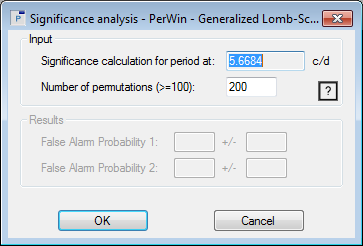Period significance
|
Peranso determines the significance of a period by calculating the False Alarm Probability (FAP) for that period, using a Fisher Randomization Test1. This test executes the selected period analysis calculation repeatedly (at least 100 times), each time shuffling the magnitude values of the observations to form a new, randomized observation set, but keeping the observation times fixed2. This randomization and period calculation loop is performed for the number of permutations specified by the user. A Fisher Randomization Test takes a considerable amount of time to execute. Using a Fisher Randomization Test, Peranso calculates 2 complimentary False Alarm Probabilities, used for determining the significance of a period P :
1-sigma errors are given on both FAP values. The lower the FAP for a given period P, the more likely P is a significant period. FAP values are expressed as a number between 0 and 1.
As a rule of thumb: FAPs below 0.01 (1%) mostly indicate very secure periods, and those between 0.01 and 0.20 are far less certain. Anything above 0.20 (20%) mostly relates to an artifact in your data, instead of a true period. Peranso displays the Period Significance Analysis dialog box to determine the significance of a period P. A full description of the dialog box is provided in Tutorial 3.
Remark
(1) More precisely, Peranso executes a permutation test or Monte Carlo Permutation Procedure (MCPP). Permutation tests are special cases of randomization tests, i.e., tests that use randomly generated numbers for statistical inference. (2) This is the so called Bootstrap method. See Press, W.H. et al., 1992, Numerical Recipes : The Art of Scientific Computing, 2nd ed, New York, Cambridge Univ. Press. (3) Heck, J., Manfroid, A., Mersch, G., 1985, Astron. Astrophys. Suppl. Ser., 59:63-72. (4) Cumming, A., Marcy, G.W., Butler, R.P., 1999, The Astrophysical Journal, 526:890-915. |
